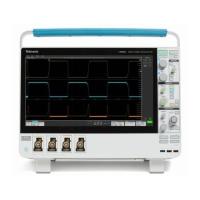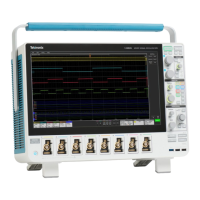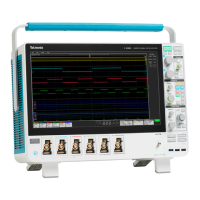Commands listed in alphabetical order
Arguments
FORWard specifi
es a forward search to the edge.
BACKWard specifi es a backward search to the edge.
Examples
MEASUrement:MEAS1:TOEDGES EARCHDIRect FORWARD specifies a forward
search to the edge.
MEASUrement:MEAS1:TOEDGES EARCHDIRect? might return
:MEASUREMENT:MEAS1:TOEDGE SEARCHDIRECT FORWARD indicating the
instrument will search in the forward direction for the to edge.
MEASUrement:MEAS<x>:TRANSition
This command sets or queries the transition edges flag for the meas urement. The
measurement number is specified by x.
Group
Measurement
Syntax
MEASUrement:MEAS<x>:TRANS ition {<NR1>|OFF|ON}
Arguments
<NR1> = 1, the measurement is computed on rising (if measurement type is
rise time) or falling edges (if measurement type is fall time) following a double
transition only. If it is set to 0 , the measurement is computed on all rising (if
measurement type is rise time) or falling (if measurement type is fall time) edges.
OFF compute s the measurement on all rising (if measurement type is rise time)
or falling (if measurement type is fall time) edges.
ON computes the measurement on rising (if measurement type is rise time) or
falling edges (if measurement type is fall time) following a double transition only.
Examples
MEASUrement:MEAS1:TRANSit ion 1 specifyingthe measurement is computed
on rising (if measurement type is rise time) or falling edges (if measurement type
is fall time) following a double transition only.
MEASUrement:MEAS1:TRANSit ion? might return
:MEASUREMENT:MEAS1:TRANSI TION 0 indicating the measurement is
computed on all rising (if measurement type is rise time) or falling (if
measurement type is fall time) edges.
MEASUrement:MEAS<x>:TYPe
This command sets or queries the measurement type. The measurement number
is specified by x.
2-488 MSO54, MSO56, MSO58, MSO58LP Programmer

